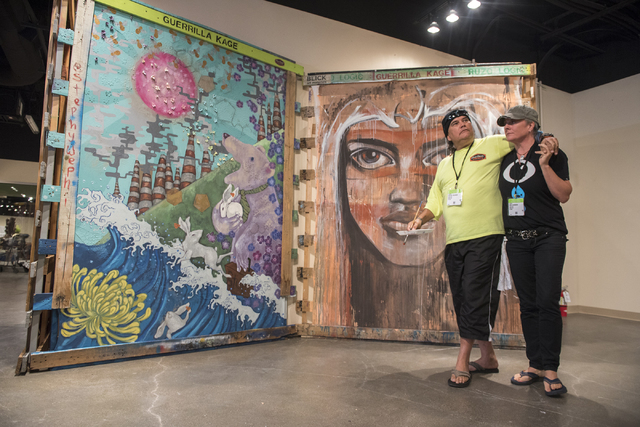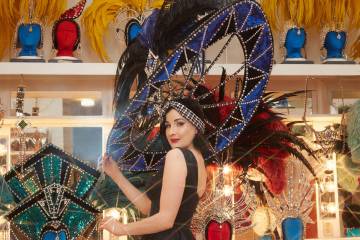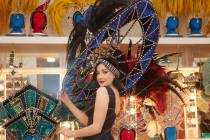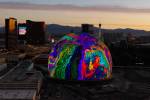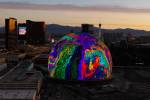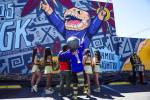Diverse group of artists take Guerrilla Kages works to open venues
I t’s the ever-popular tortured artist effect: a solitary painter wrestling with creative challenge.
But that’s not the only method of making art.
Painting on 6-by-8-foot canvases encased by “Guerrilla Kages” framed in reclaimed wood, dozens of artists — from students to established professionals — take their creativity to the streets in downtown Las Vegas and in The Park (the one that leads from the Strip to the T-Mobile Arena, that is).
Even in a World Market Center convention hall, surrounded by furniture, table settings and mattresses, the oversize Guerrilla Kages canvases attract attention.
At the recent Las Vegas Market, Mark Slotta of the locally based Office Furniture Concepts, ponders an abstract Guerrilla Kages work — and corporate America’s idea of what he calls a “statement art piece.”
Some of the Guerrilla Kages works “would make the wrong statement,” Slotta says. “Or not the wrong statement, but they make a little bit too strong a statement.”
Which is precisely the point.
Artists Ruzo Logic and Kim Johnson — whose District Artz nonprofit group organizes the Guerrilla Kages shows — define their “guerrilla art” philosophy as “art in public, not public art,” Logic says.
“What makes Guerrilla Kages so successful is diversity,” he adds, with high school and college students painting side by side with established artists.
It’s an informative — and inspirational — experience for students, according to UNLV junior Melissa Del Rosario, who met Logic at a First Friday event and then joined the Facebook group Logic uses to communicate with local artists.
“They don’t care about who you are as an artist, just what you do,” Del Rosario says. “They don’t ask you how experienced you are, they don’t judge you.”
The fact that Las Vegas Academy art students are “bumpin’ brushes,” painting in public alongside established artists “sends chills down my spine,” says Kelly Mabel, head of the academy’s art department.
In addition, collaborating on Guerrilla Kages paintings has enabled students to “really engage in some pretty amazing conversations,” she says, not only with fellow artists but “the general public (who) feel free to walk up and give feedback.”
Watching artists at work on the three-sided Guerrilla Kages canvases provides “a certain interaction and appreciation,” Logic says. “People cheer you on and reinforce what you’re doing. When you connect the artist to the public and the public to the artist, it’s a whole different dimension.”
That interaction will continue at The Park (the next Guerrilla Kages installation is scheduled Oct. 24-Nov. 7) and at a planned Dia de los Muertos art festival at Freedom Park targeting “Hispanic millennials,” who represent “43 percent of the Las Vegas market,” Logic says.
For now, Logic and Johnson are busy planning to move their arts district headquarters — an apartment-turned-studio dubbed “the bunker” — a few doors down to a vintage house with room to expand.
Inside “the bunker,” a hundred or so paint cans (provided by a corporate sponsor, Dunn-Edwards Paints) sit stacked against one wall, sharing the cramped space with Logic’s home gym. Another wall houses bookshelves and Logic’s computer.
Outside the studio, completed Guerrilla Kage canvases line the street and walkway, while stacks of reclaimed wood await their fate as Guerrilla Kage frames.
It’s a long way from the casinos that first brought Logic to Las Vegas more than two decades ago as a design fabricator on projects such as the then-Las Vegas Hilton’s “Star Trek” attraction, the Stratosphere and Steve Wynn’s Encore.
Seven years ago, Logic had a heart attack — “that’s what a hundred hours a week will do to you,” he says ruefully — and “when they were shocking me for a second time, that’s pretty much when I gave it all up,” he says.
Researching street art, he wondered “how do you create art at the scale of an alley that you can sell the same day or exhibit anywhere you want? Or produce an event that allows from one to a hundred artists to paint within a few days?”
Those questions led to Guerrilla Kages’ First Friday debut in September 2014 — and Logic’s switch in focus from “self-centered to other-centered,” he says.
The funds generated by the Guerrilla Kages shows at The Park, for example, fund Daybreak, a mural project teaming East Las Vegas kids with Metropolitan police officers. (It’s on hiatus until the weather cools off, Johnson adds.)
A painting program for Alzheimer’s patients at a local senior care center is in the planning stages.
And Park guests “really enjoyed exploring the various Kages and interacting with the artists” during July’s installation, according to Don Thrasher, president of Park District Holdings. “It’s quite entertaining” for visitors “to sit and watch the artist paint.”
It’s also enlightening for the artists, says Izaac Zevalking — who usually goes by his nom-de-art, Recycled Propaganda.
The live painting on Guerrilla Kages “bridges the street stuff and the gallery stuff,” Zevalking adds — and also bridges the gap between traditional art patrons and “a more generic audience” by “turning them into art appreciators.”
In Logic’s view, “art has to be more of a social activity” than the traditional solitary-artist-facing-an-easel.
“There’s nothing really exciting about that,” he says. By contrast, painting live on the Guerrilla Kages canvases, “I’ve never worked this big. I’ve never worked this free. I’ve never really had the carefree nature of the finished project. You don’t have to do anything except enjoy yourself.”
Read more stories from Carol Cling at reviewjournal.com. Contact her at ccling@reviewjournal.com and follow @CarolSCling on Twitter.





